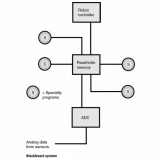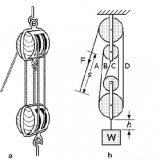What is Handy Board ? 51058
The Handy Board is a 6811-based microcontroller system that lets you build mobile robots for educational, hobbyist, and industrial purposes. People use the Handy Board to run robot design courses and competitions at the university and high school level, build robots for fun, and control industrial devices.
The Handy Board is a popular handheld robotics controller. The Handy Board was developed at MIT by Fred G. Martin, and was closely based on a previous controller designed by Martin and Randy Sargent for the MIT LEGO Robot Contest. The Handy Board design is licensed free of charge. Thus, several manufacturers make Handy Boards. The Handy Board is used by hundreds of schools worldwide and by many hobbyists for their robot projects.
Handy Board Specs
– 68HC11 8-bit microcontroller @ 2 MHz
– 32KB battery-backed SRAM
– 2×16 LCD character display
– Support for four 1A motors
– 6 Servo motor controllers
– 7 Digital and 9 Analog inputs
- 8 Digital and 16 Analog outputs
- Infrared I/O capabilities
– Serial interface capabilities
– Sound output
– 11 cm x 8.5 cm x 5.25 cm (lxwxh – with battery, expansion board, and lcd screen)
Download – Handy Board Manual PDF
VIDEO – Light Controlled Handyboard Cricket
Handyboard Lego Robot Line Following
HANDY BOARD QUESTIONS ?
How can I choose between the RCX and the Handy Board?
-The great strength of the LEGO Mindstorms system and its RCX brick is that it genuinely an everything-included, out-of-the box robotics building system. When you buy the Robotic Invention System, you get the RCX brick controller, motors, sensors, a big kit of LEGO, software, and everything else to make it all work.
-The Handy Board is more suitable when you don’t mind a little soldering to build your sensors and motors, but want something more expandable and with more inputs and outputs.
-To compare, the Handy Board can drive 4 motors and has direct inputs for 16 sensors, while the RCX brick does 3 motors and 3 sensors.
-The Handy Board’s design is open and fully documented; it is much easier to connect your own unique hardware to the Handy Board than it is to the RCX.
-The design of the RCX brick has been reverse-engineered and published by hobbyists, but it is still fairly tricky to connect unusual hardware to the RCX and then write software drivers to make that hardware work.
-The Handy Board is more expensive than the RCX: A Handy Board costs $200 to $300 for the assembled/tested board alone, while $200 buys you a Mindstorms RCX brick, plus 2 motors, 3 sensors, and a kit of 700+ LEGO pieces.
What kinds of motors are compatible with the Handy Board?
-The Handy Board is designed for motors that will operate at 9 volts and draw up to 1 ampere of current maximum. This includes all of the motors sold by the LEGO Group (the 9v standard motor, 9v gear motor, and 9v micro motor) and a variety of hobby motors.
-A motor draws its maximum amount of current when it is stalled (this is sometimes referred to as the “stall current”). A good way to get an estimate of how much current this will be at the Handy Board’s rated 9v supply level is to measure the motor’s resistance using a standard VOM (volt-ohm meter), and apply the Ohm’s Law formula current = voltage divided by resistance. Set the meter to its most sensitive resistance scale (typically, 0 to 200 ohms), apply the probes to the motor terminals, and gently rotate the motor shaft by hand until you obtain the smallest possible reading. The idea is to find the static position of the shaft that gives you the lowest ohmage reading and take that as the measurement.
-If this reading is nine ohms or more, then the motor should be compatible with the Handy Board. (At 9 volts, a 9 ohm reading would mean a current draw of one amp, the maximum the Handy Board can deliver.) If the reading is less than four ohms, the motor will probably draw too much current and won’t work.
-Please be aware that the Handy Board is not compatible with 3v to 4.5v motors found in many toy cars. These inexpensive motors are extremely noisy from an electrical standpoint; also, they typically will draw several amperes of current, thereby overloading the Handy Board’s motor drivers and causing the board to reset.
-The Handy Board also is not compatible with motors used in high end radio control cars. These motors are designed to draw huge amounts of power—25, 50, or more amperes of current.
How many servo motors can I drive from the Handy Board?
-The Handy Board itself comes with drivers to run two servo motors. With the Expansion Board, the Handy Board can run six servo motors.
Resources:
http://en.wikipedia.org/wiki/Handy_Board
http://handyboard.com/oldhb/faq/display-all.phtml#whyhb
http://handyboard.com/





